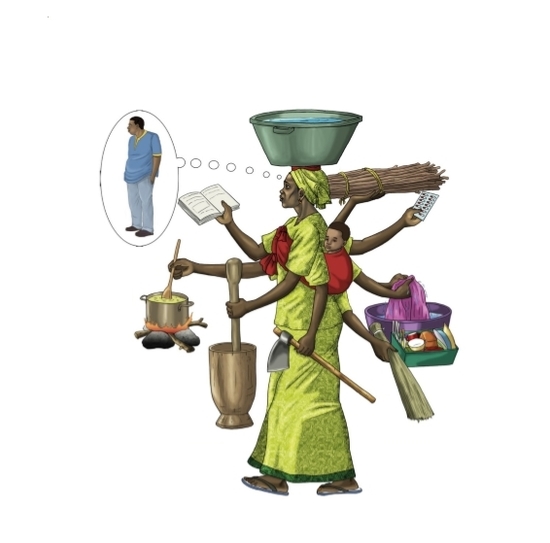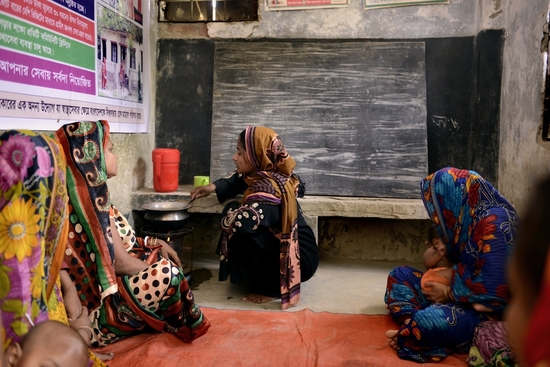article
Gender and nutrition: heavy women workload at stake
12/06/2018
© Sanjit Das, Action contre la Faim
Field evidence gathered by Action Against Hunger demonstrates that “Women’s heavy workload” is probably the most impactful.. This article shows that a heavy workload is spontaneously and strongly identified by communities as one of the most important contributors to child undernutrition. Simply recognizing the impact of women’s heavy workload on child nutrition is a positive step forward—and opens the door to making improvement and lasting change.
As all situations differ and cannot all be explained simply by looking at the UNICEF Conceptual Framework, Action against Hunger developed a methodology to deeply understand the underlying causes of undernutrition in a specific situation. The Link NCA[3] methodology is a participative, quantitative and qualitative method to identify the causes of undernutrition. It promotes the implementation of adapted responses by all organizations involved in nutrition security programming. During the qualitative inquiry phase of Link NCA studies, communities are invited to express their opinions and, in this scenario, perceptions on the causes of undernutrition and risk factors related to women’s social status often emerge.
Women’s social status is a difficult concept to define. For the purpose of this article we decided to rely on Dixon-Mueller’s definition and considered it as the degree of women’s power of decision on and women’s access to (and control over) material/economic resources (including food, income, land, and other forms of wealth), to socio-cultural resources (including knowledge, power, and prestige) and to legal resources (including rights over legislative entitlement) relative to men’s within the family, the community, and the society at large.[4]
A meta-analysis was recently conducted on 27 Link NCAs to assess the influence of women’s social status in the pathways to undernutrition. This study identified multiple causes of undernutrition related to women’s status, and more specifically, six of them with the following ranking:
1) Women's heavy workload (24 Link NCAs)
2) Poor maternal health (WHO definition) and inadequate family planning (21 Link NCAs)
3) Limited access to education for girls and young women (17 Link NCAs)
4) Early pregnancy and childbearing (15 Link NCAs)
5) Low decision power of women in the household (13 Link NCAs)
6) Women and social status and social norms (9 Link NCAs)
Women’s aggregated work overload: a factor to take into account in nutrition programs
“Although it is often pointed out that women’s involvement in income generating activities (IGA) and/or agriculture improves nutrition outcomes through an increased production and food availability, the critical issue of women’s multiple roles within households, the higher workload and the trade-offs involved, especially when considering child care and feeding, are not always emphasized”[5]. Most of the time, in addition to farming or generating income, women are indeed responsible for fetching water and firewood, and ensuring the totality of domestic work, even during pregnancy, in spite of the known negative consequences (of what?) on the birth weight of children and their anthropometry and the threat to their potential development[6].
While « care for women » is at the center of the UNICEF Conceptual Framework, « women’s aggregated work overload » often identified by the communities, is not in the causal framework. The absence of this factor means that it is rarely taken into account for nutrition security programming. Furthermore, even if, “women’s aggregated heavy workload” is revealed as a major risk factor to field operators, they often assume that nothing can be done about the situation, as they do not have the capacity or the appropriate tools to tackle it. It is often believed that, as technology acted as a catalyst for women’s empowerment and greater sex equality in the western world, technology and infrastructure is also the only solution in the South. The necessary improvements required to access technology and infrastructure in low and middle-income countries cannot be achieved in the short-term, and as a result programs tends to overlook this vital issue.
Yet solutions exist and deserve to be further explored
Link NCAs and communication within communities can provide us with simple but innovative solutions. Activities to alleviate women’s workload can be explored and distributed more evenly between men and women, thus having a potential positive impact on undernutrition as well as on women’s health and social status.
The example of Niger
The Link NCA study in Niger in 2017[7] presents one of the most blatant examples of women’s heavy workloads. In the Mayahi region, we observed that women worked every day of the week. Five days a week, they had to take care of their husband’s field, as free labor. The two remaining days of the week, women work on their own field, which provides food for the household. On top of that, they are also in charge of all the domestic work, as well as fetching the water and the firewood. If a child is sick and has to be taken to the health center, the women will have to take the day off working in their own field or their husband’s field, in the latter case, they will owe their husbands a day of work. When women’s heavy workload was discussed within the community, the issue of water spontaneously came up as a potential first lead to rebalance this burden. Both men and women refused the idea of men carrying water on their heads. The reason for this is that it is associated with femininity and therefore, is not socially acceptable. However, it was suggested that this could be overcome if men used a cart to carry the jugs of water instead, and thus a simple solution to encourage men to take over this task was found.
Solutions such as community day-care for children have also been implemented. For example, Save The Children carried out a community preschool program in Mozambique as part of the World Bank’s objective to ensure high-quality childcare centers for young children[8]. Targeting issues related to access to water and energy could be viable solutions to alleviate women’s heavy workload. In Mali, Afrique 70, constructed water fountains in villages. While the quality of the water was not improved, women saved time on this task, increasing the amount of time they could spend taking care of their children[9]. UNFPA, in Niger created a program called “Husbands’ School” to sensitize husbands to the sexual and reproductive health, thus potentially having an impact on maternal and child health. Following this example, Action Against Hunger India implemented “Men’s alliance for improved nutrition groups”. These behavior change groups for men were put in place to increase the involvement of fathers in the family’s tasks, focusing on children and alleviating the women’s dual burden. It was observed that the men’s groups have substantially helped change family dynamics as well as community development.
In order to give this major contributory factor the place it deserves, we recommend:Rendering “women’s heavy workload” visible by including it in the underlying causes of undernutrition in the UNICEF Conceptual Framework of the determinants of child undernutrition;
Consulting and involving communities in the design of innovative and socially acceptable solutions to initiate this change;
Capitalizing and disseminating successful and evidence-based experiences.
Bibliographic references :
[1] Smith & Haddad, 2015, Reducing Child Undernutrition: Past Drivers and Priorities for the Post-MDG Era. World Development, 68
[2] https://www.unicef.org/nutrition/files/Unicef_Nutrition_Strategy.pdf
[3] http://linknca.org/index.htm
[4] Dixon-Mueller, 1978, Rural Women at Work: Strategies for Development in South Asia. Washington DC: RFF Press.
[5] Jones, Cruz Agudo, Galway, Bentley, & Pinstrup-Andersen, 2012, Heavy Agricultural Workloads and Low Crop Diversity Are Strong Barriers to Improving Child Feeding Practices in the Bolivian Andes. Social Science and Medicine.
[6] Vir, 2016, Improving women’s Nutrition Imperative for Rapid Reduction of Childhood Stunting in South Asia: Coupling of Nutrition Specific Interventions with Nutrition Sensitive Measures Essential. Maternal and Child Nutrition ; Cunningham, Ruel, Ferguson, & Uauy, 2014, Women’s empowerment and Child Nutrition Status in South Asia: A synthesis of the literature. Maternal and Child Nutrition.
[7] http://linknca.org/etude/departement_de_mayadi_region_de_maradi.htm
[8] http://www.worldbank.org/en/topic/earlychildhooddevelopment#2
[9] Philippe Bernard, 2009, « La surcharge de travail des femmes africaines entrave le développement économique du continent », www.lemonde.fr/societe/article/2009/03/07/la-surcharge-de-travail-des-femmes-africaines-entrave-le-developpement-economique-du-continent_1164861_3224.html
- Underlying causes of undernutrition & linkages with gender equality
As all situations differ and cannot all be explained simply by looking at the UNICEF Conceptual Framework, Action against Hunger developed a methodology to deeply understand the underlying causes of undernutrition in a specific situation. The Link NCA[3] methodology is a participative, quantitative and qualitative method to identify the causes of undernutrition. It promotes the implementation of adapted responses by all organizations involved in nutrition security programming. During the qualitative inquiry phase of Link NCA studies, communities are invited to express their opinions and, in this scenario, perceptions on the causes of undernutrition and risk factors related to women’s social status often emerge.
Women’s social status is a difficult concept to define. For the purpose of this article we decided to rely on Dixon-Mueller’s definition and considered it as the degree of women’s power of decision on and women’s access to (and control over) material/economic resources (including food, income, land, and other forms of wealth), to socio-cultural resources (including knowledge, power, and prestige) and to legal resources (including rights over legislative entitlement) relative to men’s within the family, the community, and the society at large.[4]
A meta-analysis was recently conducted on 27 Link NCAs to assess the influence of women’s social status in the pathways to undernutrition. This study identified multiple causes of undernutrition related to women’s status, and more specifically, six of them with the following ranking:
1) Women's heavy workload (24 Link NCAs)
2) Poor maternal health (WHO definition) and inadequate family planning (21 Link NCAs)
3) Limited access to education for girls and young women (17 Link NCAs)
4) Early pregnancy and childbearing (15 Link NCAs)
5) Low decision power of women in the household (13 Link NCAs)
6) Women and social status and social norms (9 Link NCAs)
- Women’s aggregated workload as a major factor in child undernutrition
While « care for women » is at the center of the UNICEF Conceptual Framework, « women’s aggregated work overload » often identified by the communities, is not in the causal framework. The absence of this factor means that it is rarely taken into account for nutrition security programming. Furthermore, even if, “women’s aggregated heavy workload” is revealed as a major risk factor to field operators, they often assume that nothing can be done about the situation, as they do not have the capacity or the appropriate tools to tackle it. It is often believed that, as technology acted as a catalyst for women’s empowerment and greater sex equality in the western world, technology and infrastructure is also the only solution in the South. The necessary improvements required to access technology and infrastructure in low and middle-income countries cannot be achieved in the short-term, and as a result programs tends to overlook this vital issue.
The example of Niger
The Link NCA study in Niger in 2017[7] presents one of the most blatant examples of women’s heavy workloads. In the Mayahi region, we observed that women worked every day of the week. Five days a week, they had to take care of their husband’s field, as free labor. The two remaining days of the week, women work on their own field, which provides food for the household. On top of that, they are also in charge of all the domestic work, as well as fetching the water and the firewood. If a child is sick and has to be taken to the health center, the women will have to take the day off working in their own field or their husband’s field, in the latter case, they will owe their husbands a day of work. When women’s heavy workload was discussed within the community, the issue of water spontaneously came up as a potential first lead to rebalance this burden. Both men and women refused the idea of men carrying water on their heads. The reason for this is that it is associated with femininity and therefore, is not socially acceptable. However, it was suggested that this could be overcome if men used a cart to carry the jugs of water instead, and thus a simple solution to encourage men to take over this task was found.
Solutions such as community day-care for children have also been implemented. For example, Save The Children carried out a community preschool program in Mozambique as part of the World Bank’s objective to ensure high-quality childcare centers for young children[8]. Targeting issues related to access to water and energy could be viable solutions to alleviate women’s heavy workload. In Mali, Afrique 70, constructed water fountains in villages. While the quality of the water was not improved, women saved time on this task, increasing the amount of time they could spend taking care of their children[9]. UNFPA, in Niger created a program called “Husbands’ School” to sensitize husbands to the sexual and reproductive health, thus potentially having an impact on maternal and child health. Following this example, Action Against Hunger India implemented “Men’s alliance for improved nutrition groups”. These behavior change groups for men were put in place to increase the involvement of fathers in the family’s tasks, focusing on children and alleviating the women’s dual burden. It was observed that the men’s groups have substantially helped change family dynamics as well as community development.
- Recommendations to address the issue of women’s work overload
In order to give this major contributory factor the place it deserves, we recommend:





